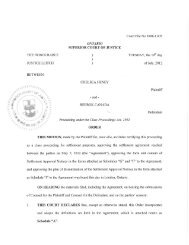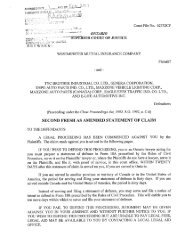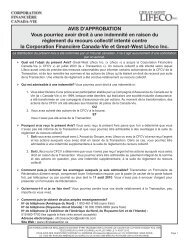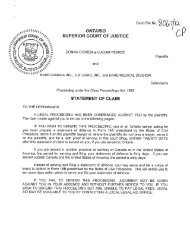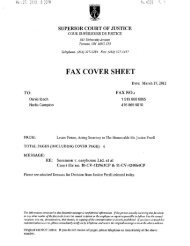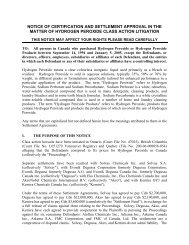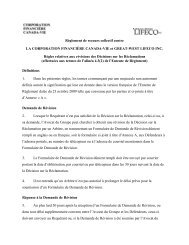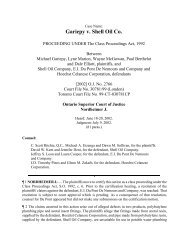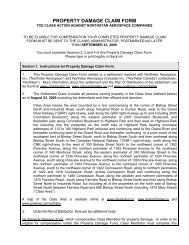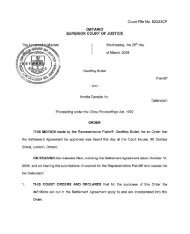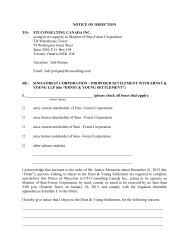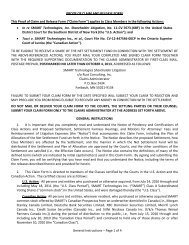NOTICE OF PENDENCY AND CERTIFICATION ... - Gilardi & Co, LLC
NOTICE OF PENDENCY AND CERTIFICATION ... - Gilardi & Co, LLC
NOTICE OF PENDENCY AND CERTIFICATION ... - Gilardi & Co, LLC
You also want an ePaper? Increase the reach of your titles
YUMPU automatically turns print PDFs into web optimized ePapers that Google loves.
<strong>NOTICE</strong> <strong>OF</strong> <strong>PENDENCY</strong> <strong>AND</strong> <strong>CERTIFICATION</strong> <strong>OF</strong> CLASS ACTIONS, PROPOSED SETTLEMENT <strong>AND</strong> SETTLEMENT<br />
APPROVAL/FAIRNESS HEARINGS<br />
UNITED STATES DISTRICT COURT<br />
SOUTHERN DISTRICT <strong>OF</strong> NEW YORK<br />
x<br />
In re CANADIAN SUPERIOR SECURITIES<br />
: Master File No. 1:09-cv-10087-SAS<br />
LITIGATION<br />
:<br />
: CLASS ACTION<br />
This Document Relates To:<br />
:<br />
ALL ACTIONS.<br />
:<br />
:<br />
:<br />
x<br />
<strong>Co</strong>urt File No.: 1626CP<br />
ONTARIO<br />
SUPERIOR COURT <strong>OF</strong> JUSTICE<br />
B E T W E E N<br />
DOUGLAS DEVLIN, et al.<br />
Plaintiffs<br />
- and –<br />
GREG S. NOVAL, LEIGH BILTON, MICHAEL E. COOLEN,<br />
CHARLES DALLAS, THOMAS J. HARP, CRAIG MCKENZIE, ALEX<strong>AND</strong>ER SQUIRES,<br />
ROBB D. THOMPSON, RICHARD WATKINS, LEIF SNETHUN,<br />
SONDE RESOURCES CORP. (f.k.a. CANADIAN SUPERIOR ENERGY INC.) and<br />
CHALLENGER ENERGY CORP.<br />
Defendants<br />
Proceeding under the Class Proceedings Act, 1992<br />
<strong>Co</strong>urt File No.: 1358/10CP<br />
ONTARIO<br />
SUPERIOR COURT <strong>OF</strong> JUSTICE<br />
B E T W E E N<br />
DOUGLAS DEVLIN<br />
Plaintiff<br />
- and –<br />
GREG S. NOVAL, LEIGH BILTON, MICHAEL E. COOLEN,<br />
CHARLES DALLAS, THOMAS J. HARP, CRAIG MCKENZIE, ALEX<strong>AND</strong>ER SQUIRES, ROBB D. THOMPSON, RICHARD<br />
WATKINS, LEIF SNETHUN,<br />
CANADIAN SUPERIOR ENERGY INC. and<br />
CHALLENGER ENERGY CORP.<br />
Defendants<br />
Proceeding under the Class Proceedings Act, 1992<br />
<strong>Co</strong>urt File No.: CV-10-14848<br />
ONTARIO<br />
SUPERIOR COURT <strong>OF</strong> JUSTICE<br />
B E T W E E N<br />
ROBERT RAE<br />
Plaintiff<br />
- and –<br />
GREGORY S. NOVAL, CRAIG MCKENZIE,<br />
MICHAEL E. COOLEN, ROBB THOMPSON and ALEX<strong>AND</strong>ER SQUIRES<br />
Defendants<br />
Proceedings under the Class Proceedings Act, 1992<br />
This Notice provides you with important information concerning the proposed settlement (the “Settlement”) of class action<br />
lawsuits (the “Actions”) separately brought by three representative plaintiffs (the “Canadian Representative Plaintiffs”) in Canada<br />
(the “Canadian Actions”) and Gino Ströker (the “U.S. Lead Plaintiff”) in the United States (the “U.S. Action”), on behalf of<br />
themselves and the classes described herein, against Gregory S. Noval, Michael E. <strong>Co</strong>olen, Craig McKenzie, Leif Snethun, Leigh<br />
Bilton, Charles Dallas, Thomas J. Harp, Alexander Squires, Robb D. Thompson, Richard Watkins, Sonde Resources <strong>Co</strong>rp. (f/k/a<br />
Canadian Superior Energy Inc.) (“Sonde” or “Canadian Superior” or the “<strong>Co</strong>mpany”) and Challenger Energy <strong>Co</strong>rp. (“Challenger”)<br />
(collectively, the “Defendants”).<br />
IF YOU PURCHASED OR OTHERWISE ACQUIRED CANADIAN SUPERIOR COMMON STOCK BETWEEN JANUARY<br />
14, 2008 <strong>AND</strong> FEBRUARY 17, 2009, INCLUSIVE, YOUR RIGHTS MAY BE AFFECTED BY THESE CLASS ACTIONS<br />
<strong>AND</strong> YOU MAY BE ENTITLED TO A PAYMENT FROM THIS PROPOSED CLASS ACTION SETTLEMENT.<br />
This Notice was authorized and approved by the U.S. and Ontario courts in charge of the Actions. This is not a<br />
solicitation from a lawyer.
The Settlement described herein will provide a gross settlement fund of Five Million Two Hundred Thousand United States<br />
Dollars (USD$5,200,000), plus interest (the “Gross Settlement Fund”), for the benefit of investors who purchased or otherwise<br />
acquired Canadian Superior common stock between January 14, 2008 and February 17, 2009, inclusive (the “Class Period”).<br />
The Settlement resolves both Actions before the Ontario Superior <strong>Co</strong>urt of Justice (the “Ontario <strong>Co</strong>urt”) and the United States<br />
District <strong>Co</strong>urt for the Southern District of New York (the “U.S. <strong>Co</strong>urt”) (collectively, the “<strong>Co</strong>urts”) against the Defendants<br />
alleging, among other things, false and misleading public statements concerning the success of Canadian Superior’s efforts to<br />
drill for natural gas off the coast of Trinidad and Tobago in an area known as the Intrepid Block 5(c).<br />
The Settlement also includes full and final releases of known and unknown claims that are or could have been asserted in the<br />
Actions against the Defendants and others described herein (the “Released Parties”).<br />
In order to become effective, the Settlement must be approved by both <strong>Co</strong>urts.<br />
Solely for purpose of implementing the Settlement, the Ontario <strong>Co</strong>urt has certified the Canadian Actions as a class proceeding,<br />
and approved the form and method of disseminating this Notice to members of the certified class. The Ontario <strong>Co</strong>urt will<br />
conduct a hearing to consider whether to finally approve the Settlement on November 24, 2011. The class certified by the<br />
Ontario <strong>Co</strong>urt (the “Canadian Class”) is described below.<br />
Solely for purpose of implementing the Settlement, the U.S. <strong>Co</strong>urt has granted preliminary approval of the Settlement, and<br />
certified a class (the “U.S. Class”), and approved the form and method of disseminating this Notice to members of the U.S.<br />
Class. The U.S. <strong>Co</strong>urt will conduct a fairness hearing to consider whether to finally approve the Settlement on November 8,<br />
2011. The U.S. Class is described below.<br />
If the Settlement is not approved by both of the <strong>Co</strong>urts and does not become effective for that reason or as otherwise provided<br />
under the Settlement, the certification of the Canadian Class and U.S. Class respectively by each of the Ontario <strong>Co</strong>urt and the<br />
U.S. <strong>Co</strong>urt will be set aside.<br />
If the <strong>Co</strong>urts approve the Settlement, your legal rights will be affected by this Settlement whether you act or do not<br />
act. Please read this Notice carefully.<br />
YOUR LEGAL RIGHTS <strong>AND</strong> OPTIONS IN THIS SETTLEMENT<br />
SUBMIT A PRO<strong>OF</strong> <strong>OF</strong> CLAIM<br />
The only way to get a payment. A Proof of Claim form must be submitted by<br />
EXCLUDE YOURSELF (Opt out of the<br />
Canadian Class/U.S. Class)<br />
OBJECT<br />
GO TO THE COURT SETTLEMENT<br />
HEARINGS<br />
December 7, 2011 to the Claims Administrator (defined below).<br />
Get no payment. This is the only option that allows you to ever participate in<br />
another lawsuit against the Defendants and the other Released Parties relating<br />
to the Settled Claims (defined below). If you wish to exclude yourself, you<br />
must do so by October 10, 2011.<br />
Write to either the U.S. Lead Plaintiff’s <strong>Co</strong>unsel or to Canadian Class <strong>Co</strong>unsel<br />
(defined below) (collectively, “Plaintiffs’ <strong>Co</strong>unsel”) about why you do not like<br />
the Settlement, Plan of Allocation or attorneys’ fees and expense applications.<br />
Plaintiffs’ <strong>Co</strong>unsel will file your objection with the appropriate court but if you<br />
are a U.S. Class Member you should also send your objection directly to the<br />
U.S. <strong>Co</strong>urt. If you wish to object, you must do so by October 10, 2011.<br />
If you have submitted an objection, you may also ask to speak to the U.S. <strong>Co</strong>urt<br />
or the Ontario <strong>Co</strong>urt about your decision to object. You must provide notice of<br />
your desire to do so within your written objection by October 10, 2011.<br />
DO NOTHING<br />
Get no payment. Give up rights to participate in any other lawsuit against the<br />
Defendants and the other Released Parties in respect of Settled Claims<br />
(defined below).<br />
These rights and options – and the deadlines to exercise them – are explained in this Notice.<br />
The <strong>Co</strong>urts still have to decide whether to approve the Settlement. Payments will be made only if both <strong>Co</strong>urts approve the Settlement<br />
and after any appeals are resolved and all Proof of Claim forms have been reviewed and processed. Please be patient.<br />
Summary Notice<br />
Statement of Plaintiff Recovery:<br />
Pursuant to the Settlement, a Gross Settlement Fund consisting of Five Million Two Hundred Thousand United States Dollars<br />
(USD$5,200,000) in cash, plus interest thereon, has been established. Plaintiffs estimate that there were approximately 113 million<br />
shares of Canadian Superior common stock that traded on the Toronto Stock Exchange (“TSX”) and American Stock Exchange<br />
(“AMEX”) during the Class Period that may have been damaged. Plaintiffs estimate that the average recovery per damaged<br />
Canadian Superior share is approximately USD$0.046 before deduction of <strong>Co</strong>urt-approved attorneys’ fees and expenses.<br />
A Canadian Class Member’s and/or U.S. Class Member’s (“Class Member”) actual recovery under the Settlement will be a<br />
proportion of the Net Settlement Fund (as defined under Question 8 below) determined by that claimant’s recognized loss as<br />
compared to the total recognized losses of all Class Members who submit acceptable Proofs of Claim. Depending on the number<br />
of claims submitted, the number of shares purchased or acquired, the exchange on which those shares were purchased or<br />
acquired, and the timing of his, her, or its purchases and sales (if any), an individual Class Member may receive more or less than<br />
this average amount. See the Plan of Allocation of the Net Settlement Fund on page 10 of this Notice for more information about<br />
the determination of each Class Member’s potential recovery under this Settlement.<br />
Statement of Potential Outcome of Case:<br />
The parties in the Actions vigorously disagree on all elements of liability and damages, and do not agree on the amount of<br />
damages per security that would be recoverable if the Plaintiffs were to have prevailed on each claim alleged in the Actions. The<br />
Defendants in the Actions deny that they are liable to Plaintiffs or to Class Members and deny that the Plaintiffs or Class Members<br />
have suffered any damages.<br />
2
The issues on which the parties disagree include, among other things: (i) whether the Defendants made any materially false<br />
or misleading statements or otherwise failed to meet any disclosure obligations during the Class Period; (ii) whether any of the<br />
alleged materially false or misleading statements or omissions were made with the requisite level of intent or are otherwise<br />
actionable under the United States Securities Exchange Act of 1934, the Ontario Securities Act, or Canadian common law; (iii)<br />
whether members of the Canadian Class relied on the alleged misstatements in purchasing Canadian Superior common stock<br />
during the Class Period; (iv) whether the various matters alleged in the Actions influenced the trading price of Canadian Superior<br />
common stock at various times during the Class Period; (v) the extent to which other factors beyond those alleged in the Actions<br />
influenced the trading price of Canadian Superior common stock at various times during the Class Period; and (vi) the appropriate<br />
model for determining whether the prices of Canadian Superior common stock were artificially inflated during the Class Period by<br />
reason of the alleged materially false or misleading statements or omissions and the extent, if any, of such inflation.<br />
Statement of Attorneys’/Lawyers’ Fees and Expenses Sought:<br />
<strong>Co</strong>unsel for the Canadian Class in the Canadian Action (“Canadian Class <strong>Co</strong>unsel”) will ask the Ontario <strong>Co</strong>urt for an award<br />
of lawyers’ fees not to exceed 25% of 40% of the Gross Settlement Fund, plus interest on such fees, and an additional amount to<br />
be paid from the Gross Settlement Fund for reimbursement of expenses, plus applicable taxes on the fees and expenses.<br />
Canadian Class <strong>Co</strong>unsel will ask the Ontario <strong>Co</strong>urt for expenses incurred in connection with the prosecution of the Canadian<br />
Actions in the approximate amount of CAD$75,000, plus applicable taxes.<br />
<strong>Co</strong>unsel for the U.S. Class in the U.S. Action (“U.S. Lead Plaintiff’s <strong>Co</strong>unsel”) will ask the U.S. <strong>Co</strong>urt for an award of<br />
attorneys’ fees not to exceed 30% of 60% of the Gross Settlement Fund, and an additional amount to be paid from the Gross<br />
Settlement Fund for payment of expenses. U.S. Lead Plaintiff’s <strong>Co</strong>unsel will ask the U.S. <strong>Co</strong>urt for expenses incurred in<br />
connection with the prosecution of the U.S. Action not to exceed USD$150,000.<br />
In the aggregate, the total amount of fees requested by Plaintiffs’ <strong>Co</strong>unsel in the Actions will not exceed 30% of the Gross<br />
Settlement Fund, plus expenses to Plaintiffs’ <strong>Co</strong>unsel not to exceed USD$250,000.<br />
The attorneys and lawyers representing the Plaintiffs and Class Members in both Actions state that they have expended<br />
considerable time and effort conducting the Actions on a contingent fee basis and have advanced the expenses of the Actions in<br />
the expectation that, if they were successful in obtaining a recovery for Class Members, they would be paid from such recovery.<br />
In this type of litigation, it is customary for the attorneys and lawyers representing plaintiffs and class members to be awarded a<br />
percentage of the total recovery as their attorneys’/lawyers’ fees.<br />
Reasons for the Settlement:<br />
Based upon their investigation and evaluation of the facts and law relating to the claims asserted in the Actions, the Plaintiffs<br />
and Plaintiffs’ <strong>Co</strong>unsel agreed to the Settlement after considering, among other things: (i) the substantial benefits to Class<br />
Members of the Settlement; (ii) the uncertainty of being able to prove the allegations asserted in the Actions; (iii) the attendant<br />
risks of litigation, especially in complex actions such as these, as well as the difficulties and delays inherent in such litigation<br />
(including any appeals); (iv) the risk that the Ontario <strong>Co</strong>urt may not grant leave to pursue claims under the Ontario Securities Act;<br />
(v) the risk that one or more of the Actions would not be certified to proceed as a class action; (vi) the uncertainty, even if Plaintiffs<br />
were to establish liability at trial, inherent in the parties’ competing theories of damages; (vii) their awareness of Defendants’ likely<br />
positions on various liability and damages issues; (viii) the desirability of consummating the Settlement in order to provide certain<br />
and effective relief to Class Members without further delay; (ix) the fact that Canadian Superior had restructured pursuant to<br />
Canadian bankruptcy laws, which limited the types of claims that could be advanced against the Defendants and the potential<br />
recovery from the Defendants; and (x) their belief that the Settlement is fair, reasonable, and adequate, and in the best interests of<br />
all Class Members.<br />
Defendants’ reasons for entering into the Settlement are to bring to an end the substantial expense, burdens, risks, and<br />
uncertainties associated with continued litigation; to finally put to rest the claims and the underlying matters raised in the Actions;<br />
and to avoid further expense and disruption of the management and operation of Defendants’ business and affairs due to the<br />
prosecution and defense of the Actions. The Settlement shall not be construed as, and is not, an admission of any liability,<br />
wrongdoing, or damages whatsoever by any of the Defendants.<br />
Further Information:<br />
Further information regarding the U.S. Action and this Notice may be obtained by contacting one of the U.S. Lead Plaintiff’s<br />
<strong>Co</strong>unsel: David A. Rosenfeld, Robbins Geller Rudman & Dowd LLP, 58 South Service Road, Suite 200, Melville, NY 11747, tollfree<br />
telephone (800) 449-4900, or by visiting U.S. Lead Plaintiff’s <strong>Co</strong>unsel’s website at www.rgrdlaw.com.<br />
Further information regarding the Canadian Actions and this Notice may be obtained by contacting Canadian Class <strong>Co</strong>unsel:<br />
A. Dimitri Lascaris, Siskinds LLP, 680 Waterloo Street, P.O. Box 2520, London, ON N6A 3V8, toll-free telephone (800) 461-6166,<br />
ext. 7872, Jay Strosberg, Sutts, Strosberg LLP, 600 – 251 Goyeau Street, Windsor, ON N9A 6V4, or by visiting Canadian Class<br />
<strong>Co</strong>unsel’s website at www.classaction.ca.<br />
BASIC INFORMATION<br />
1. Why Did I Get This Notice Package<br />
The U.S. <strong>Co</strong>urt and Ontario <strong>Co</strong>urt authorized this Notice to be sent to you because you or someone in your family may have<br />
purchased or otherwise acquired Canadian Superior common stock between January 14, 2008 and February 17, 2009, inclusive.<br />
Such purchasers may be members of the respective classes certified by the U.S. <strong>Co</strong>urt and/or Ontario <strong>Co</strong>urt in the Actions.<br />
If this description applies to you or someone in your family, then you have a right to know about the settlement of the Actions,<br />
and about all of your options, before the <strong>Co</strong>urts decide whether to approve the Settlement. If the <strong>Co</strong>urts approve the Settlement,<br />
and after any appeals are resolved in favor of approval of the Settlement, an administrator appointed by the <strong>Co</strong>urts (the “Claims<br />
Administrator”) will make the payments that the Settlement allows.<br />
This Notice explains the Actions and classes certified for settlement purposes therein, the Settlement, Class Members’ legal<br />
rights, what benefits are available, who is eligible for them, and how to get them.<br />
The <strong>Co</strong>urts in charge of the Actions and consideration of whether the Settlement should be approved are as follows:<br />
3
<strong>Co</strong>urt (Address)<br />
Action<br />
Ontario Superior <strong>Co</strong>urt of Justice<br />
Devlin v. Noval, et al., <strong>Co</strong>urt File No. 1358/10CP,<br />
80 Dundas Street<br />
Devlin, et al. v. Noval, et al.,<br />
London, ON N6A 6A3<br />
<strong>Co</strong>urt File No. 1626CP, and Rae v. Noval, et al.,<br />
The Honourable Justice Rady<br />
<strong>Co</strong>urt File No. CV-10-14848 (defined above as the “Canadian Actions”)<br />
United States District <strong>Co</strong>urt for the Southern In re Canadian Superior Securities Litigation,<br />
District of New York<br />
Master File No. 1:09-cv-10087-SAS<br />
Daniel Patrick Moynihan<br />
(defined above as the “U.S. Action”)<br />
United States <strong>Co</strong>urthouse<br />
500 Pearl Street<br />
New York, NY 10007<br />
The Honorable Shira A. Scheindlin<br />
United States District Judge<br />
The individual and pension funds who sued are called the plaintiffs, and the companies and the individuals they sued are<br />
called the defendants.<br />
The Ontario <strong>Co</strong>urt will resolve the issues for all members of the Canadian Class (defined below) who do not exclude<br />
themselves from the Canadian Class. The U.S. <strong>Co</strong>urt will resolve the issues for all members of the U.S. Class (defined below)<br />
who do not exclude themselves from the U.S. Class.<br />
2. What Is This Lawsuit About<br />
Canadian Superior is a Canadian company, with its head office located in Calgary, Alberta, focusing on the exploration for,<br />
acquisition, development, and production of petroleum and natural gas, and liquefied natural gas. The <strong>Co</strong>mpany has sought<br />
protection under Canadian bankruptcy and reorganization laws and has since reorganized. It has operations in Canada, the<br />
United States, offshore Nova Scotia, offshore Trinidad and Tobago, and North Africa. During the Class Period, Canadian Superior<br />
common stock traded on the TSX and the AMEX.<br />
On February 12, 2009, Canadian Superior announced, among other things, that its interest in Intrepid Block 5(c) had been<br />
placed in a receivership upon the application of its partner in the exploration efforts, BG International Limited (“BGI”). BGI supported<br />
its application for a receivership with an affidavit from its Vice President, <strong>Co</strong>mmercial of BG Trinidad & Tobago (“BGI Affidavit”). The<br />
BGI Affidavit revealed that BGI believed the available information showed Intrepid Block 5(c) did not contain the quantity of natural<br />
gas reserves Canadian Superior had represented and did not contain information that the gas was economically viable. The BGI<br />
Affidavit also stated that Canadian Superior was in material breach of its contractual obligations at all times throughout the project<br />
and that the <strong>Co</strong>mpany lacked sufficient funds to cover its obligations to complete the exploration efforts. Following this<br />
announcement, shares of Canadian Superior common stock fell approximately 44% on both the AMEX and TSX.<br />
Plaintiffs allege that Defendants made material misstatements or omitted to state material information in Canadian Superior’s<br />
public statements during the Class Period. More specifically, the Plaintiffs alleged that the Defendants’ statements made during<br />
the Class Period were materially false and misleading when made and failed to disclose: (i) the progress of three wells at Intrepid<br />
Block 5(c); (ii) the <strong>Co</strong>mpany’s compliance with, and liability under, the Joint Operating Agreement; and (iii) the <strong>Co</strong>mpany’s inability<br />
to meet its financial obligations to the joint venture in late 2008.<br />
The U.S. Action alleges, among other things, that Defendants violated §§10(b) and 20(a) of the Securities Exchange Act of<br />
1934 (the “Exchange Act”).<br />
The Canadian Actions raise similar allegations based on Canadian common law, corporate law, and the Ontario Securities Act.<br />
The Canadian Actions and the U.S. Action seek money damages for their respective classes. The Defendants deny that<br />
they violated any laws or did anything wrong, deny that they are liable to Class Members, and deny that Class Members have<br />
suffered damages.<br />
3. What Is a Class Action<br />
In a class action, one or more people called class representatives (in this case, the Canadian Representative Plaintiffs in the<br />
Canadian Actions and the U.S. Lead Plaintiff in the U.S. Action) sue on behalf of people who have similar claims. All these people<br />
are collectively called a “Class” or “Class Members.” Bringing a case as a class action allows the adjudication of many similar<br />
claims of persons or entities that might be economically too small to bring as individual actions.<br />
4. Why Is There a Settlement<br />
The <strong>Co</strong>urts did not decide in favor of Plaintiffs or Defendants. Instead, these parties agreed to the Settlement. The<br />
Settlement avoids the risks and costs of a trial, and eligible Class Members who make a valid claim receive compensation sooner.<br />
See “Reasons for the Settlement” above. The Plaintiffs and their attorneys and lawyers in both the U.S. Action and Canadian<br />
Actions think the Settlement is fair, reasonable, and adequate and in the best interests of all Class Members.<br />
To see if you will get money from the Settlement, you first have to determine if you are a Class Member.<br />
WHO IS IN THE SETTLEMENT<br />
5. How Do I Know If I Am Eligible to Take Part in the Settlement<br />
The Ontario <strong>Co</strong>urt has directed, solely for purposes of the proposed Settlement, that everyone who fits this description is a<br />
member of the Canadian Class: All Persons, other than Excluded Persons (defined below), who purchased or otherwise<br />
acquired Canadian Superior common stock during the Class Period on the Toronto Stock Exchange.<br />
The U.S. <strong>Co</strong>urt has directed, solely for purposes of the proposed Settlement, that everyone who fits this description is a<br />
member of the U.S. Class: All Persons who purchased or otherwise acquired Canadian Superior common stock during<br />
the period between January 14, 2008 and February 17, 2009, inclusive, other than members of the Canadian Class and<br />
Excluded Persons.<br />
4
6. What Are the Exceptions to Being Included<br />
You are not a member of the U.S. Class if you are a member of the Canadian Class or any of the following “Excluded Persons”:<br />
(a) a Defendant; (b) a member of the immediate family of each current or former individual defendant in the Actions; (c) an entity in<br />
which a Defendant has a controlling interest; (d) a parent, subsidiary, or affiliate of Sonde or Challenger; (e) a director or officer of<br />
Canadian Superior during the Class Period; (f) a legal representative, heir, predecessor, successor, or assign of any Defendant in the<br />
Actions; and (g) a putative member of the Class who excludes himself or herself by timely requesting exclusion by filing an Opt-out<br />
Request with the Claims Administrator in accordance with the requirements set forth in this Notice. In addition, any Class Member<br />
who timely submits a valid request for exclusion from the U.S. Class to the Claims Administrator in accordance with the requirements<br />
and procedures set forth in this Notice is not a member of the U.S. Class and cannot participate in the Settlement.<br />
Similarly, you are not a member of the Canadian Class if you are an “Excluded Person,” or if you timely submit a valid<br />
request for exclusion from the Canadian Class to the Claims Administrator in accordance with the requirements and procedures<br />
set forth in this Notice and cannot participate in the Settlement.<br />
If one of your mutual funds purchased or acquired Canadian Superior common stock during the Class Period, that alone<br />
does not make you a Class Member. You are a Class Member only if you, your broker, or someone else purchased or acquired<br />
Canadian Superior common stock on your behalf during the Class Period. Check your investment records or contact your broker<br />
to see if you purchased or acquired Canadian Superior common stock during the Class Period.<br />
If you sold Canadian Superior common stock during the Class Period, that alone does not make you a Class Member. You are<br />
a Class Member only if you purchased or otherwise acquired Canadian Superior common stock during the Class Period.<br />
7. I Am Still Not Sure if I Am Included.<br />
If you are still not sure whether you are included, you can ask for free help. You can call, email or write to the Claims<br />
Administrator at:<br />
Canadian Address<br />
Canadian Superior Securities Litigation<br />
Claims Administrator<br />
c/o NPT Ricepoint<br />
P.O. Box 3355<br />
London, ON N6A 4K3<br />
1-866-432-5534<br />
cse@nptricepoint.com<br />
U.S. Address<br />
Canadian Superior Securities Litigation<br />
Claims Administrator<br />
c/o <strong>Gilardi</strong> & <strong>Co</strong>. <strong>LLC</strong><br />
P.O. Box 990<br />
<strong>Co</strong>rte Madera, CA 94976-0990<br />
1-877-350-6773<br />
classact@gilardi.com<br />
Alternatively, you can fill out and return the Proof of Claim form described in Question 10 below to see if you qualify.<br />
THE SETTLEMENT BENEFITS – WHAT YOU GET<br />
8. What Does the Settlement Provide<br />
In exchange for the Settlement, inclusive of the releases therein, and dismissal of the Actions, the Defendants have agreed to<br />
pay, through their insurer, Five Million Two Hundred Thousand Dollars (USD$5,200,000) in cash, plus interest earned on that sum<br />
while held in escrow, to be divided among all eligible Class Members who send in valid Proof of Claim forms, after payment of <strong>Co</strong>urtapproved<br />
attorneys’/lawyers’ fees and expenses and the costs of claims administration, including the costs of printing and mailing<br />
this Notice and the cost of publishing newspaper notices (the “Net Settlement Fund”).<br />
9. How Much Will My Payment Be<br />
If you are entitled to a payment under the Settlement, your share of the Net Settlement Fund will depend on how many Class<br />
Members send in valid Proof of Claim forms, the total recognized losses for settlement purposes (“Recognized Loss”) represented<br />
by those valid Proof of Claim forms that Class Members send in, how many shares of Canadian Superior common stock you<br />
purchased or acquired, when you purchased or acquired them, on what exchange you purchased or acquired them, how much<br />
you paid for them, when you sold them, and the price for which you sold them.<br />
You can calculate your Recognized Loss in accordance with the formula shown below in the Plan of Allocation of the Net<br />
Settlement Fund. It is unlikely that you will get a payment for your entire Recognized Loss. After all Class Members have sent in<br />
their Proof of Claim forms, the payment you get will be the proportion of the Net Settlement Fund equal to your Recognized Loss<br />
divided by the total of all Recognized Losses for Class Members who have sent in valid Proof of Claim forms. See the Plan of<br />
Allocation on page 10 for more information on your Recognized Loss.<br />
HOW YOU GET PAYMENT – SUBMITTING A CLAIM FORM<br />
10. How Will I Get a Payment<br />
To qualify for a payment, you must be a member of the Canadian Class or the U.S. Class and you must send in a timely and<br />
valid Proof of Claim form. A Proof of Claim form is enclosed with this Notice. Read the instructions carefully, fill out the form,<br />
include all the documents the form asks for, sign it, and mail it to the Claims Administrator at the P.O. Box address on the form by<br />
first-class mail, postmarked no later than December 7, 2011.<br />
If you did not receive a Proof of Claim form, you can get one on the internet at www.classaction.ca, www.jssbarristers.ca,<br />
www.rgrdlaw.com, www.gilardi.com or www.nptricepoint.com. You can also ask for a Proof of Claim form by calling toll-free<br />
1-877-350-6773 in the U.S., or 1-866-432-5534 in Canada.<br />
11. When Will I Get My Payment<br />
The U.S. <strong>Co</strong>urt will hold a hearing on November 8, 2011, to decide whether to approve the Settlement. The Ontario <strong>Co</strong>urt<br />
will hold a hearing on November 24, 2011, to decide whether to approve the Settlement. Both <strong>Co</strong>urts must approve the<br />
Settlement for the Settlement to become effective. After the <strong>Co</strong>urts decide these issues, however, there may be appeals from<br />
those decisions. It is always uncertain whether these appeals can be resolved favorably in support of the Settlement, and<br />
resolving them can take time, perhaps more than a year. It also takes a long time, often as much as a year, for all the Proofs of<br />
Claim submitted to be accurately reviewed and processed. Please be patient.<br />
5
12. What Am I Giving Up to Get a Payment and Stay in the Class<br />
Unless you exclude yourself (“opt out”) from the Settlement in the manner described in this Notice, you are staying in the<br />
Class. That means that, upon the Effective Date (defined below), you (and your personal representatives, agents, heirs,<br />
executors, administrators, trustees, beneficiaries, current and former plan members and contributors, successors, assigns and<br />
any persons you represent in relation to Canadian Superior common stock purchased or otherwise acquired during the Class<br />
Period or in relation to the “Settled Claims” (defined below)) will be held to have released and forever discharged the “Released<br />
Parties” in respect of the Settled Claims and will be barred and enjoined from suing, continuing to sue, or being part of any other<br />
lawsuit against the Released Parties relating to the Settled Claims.<br />
It also means that if you are a member of the Canadian Class, all of the Ontario <strong>Co</strong>urt’s orders will apply to you and legally<br />
bind you, and if you are a member of the U.S. Class, all of the U.S. <strong>Co</strong>urt’s orders will apply to you and legally bind you, both of<br />
which include terms providing for such release of and bar against further suits by Class Members relating to Settled Claims<br />
against the Released Parties.<br />
“Released Parties” means any and all of the Defendants, and each of their respective present and former parents,<br />
subsidiaries, affiliates, officers, directors, employees, general or limited partners or partnerships, foundations, trusts, principals,<br />
trustees, attorneys, legal counsel, auditors, accountants, investment bankers, consultants, agents, insurers (including Defendants’<br />
Insurers), co-insurers, heirs, executors, administrators, predecessors, successors and assigns.<br />
“Settled Claims” means any and all claims, debts, demands, rights, actions, causes of action, suits, matters, issues, damages,<br />
losses or liabilities whatsoever (including, but not limited to, any claims for interest, attorneys’ fees, expert or consulting fees, and any<br />
other costs, expenses or liability whatsoever), whether based on United States or Canadian federal, state, provincial, local, statutory<br />
or common law or any other law, rule or regulation, whether fixed or contingent, accrued or unaccrued, liquidated or unliquidated, at<br />
law or in equity, matured or unmatured, whether class or individual in nature, including both known claims and Unknown Claims (as<br />
defined below) (i) that have been asserted in any of the Actions against any of the Released Parties; or (ii) that could have been<br />
asserted in any forum by the Class Members or any of them (as purchasers of Canadian Superior common stock during the Class<br />
Period) against any of the Released Parties which arise out of or are based upon the allegations, transactions, facts, matters,<br />
breaches, occurrences, financial statements, statements, representations or omissions involved, set forth, or referred to in the<br />
Actions (except that Settled Claims does not include claims, rights or causes of action or liabilities whatsoever (i) to enforce the<br />
Settlement; and (ii) for breach or violation of any of the terms of the Stipulation or orders or judgments issued by the <strong>Co</strong>urts in<br />
connection with the Settlement or confidentiality obligations with respect to settlement communications).<br />
“Unknown Claims” means any and all Settled Claims which any of the Plaintiffs or the Class Members do not know or<br />
suspect to exist in their favor at the time of the Effective Date, and any Settled Defendants’ Claims which any Defendant does not<br />
know or suspect to exist in his or its favor at the time of the Effective Date which if known might have affected the decisions with<br />
respect to the Settlement and releases therein. With respect to any and all Settled Claims and Settled Defendants’ Claims, the<br />
parties stipulate and agree that, upon the Effective Date, Plaintiffs and Defendants shall expressly waive, and each Class Member<br />
shall be deemed to have waived, and by operation of the judgments shall have expressly waived, any and all provisions, rights<br />
and benefits conferred by any law of any state, province, or territory of the United States or Canada, or principle of common law or<br />
otherwise, which provides that a general release does not extend to claims which a creditor or releasor does not know or suspect<br />
to exist in their favor at the time of executing the release which, if known, might have materially affected their settlement and<br />
release of individuals and persons, including any provisions, rights or benefits under California Civil <strong>Co</strong>de §1542, which provides:<br />
A general release does not extend to claims which the creditor does not know or suspect to exist in his or<br />
her favor at the time of executing the release, which if known by him or her must have materially affected his or<br />
her settlement with the debtor.<br />
Plaintiffs and Class Members may hereinafter discover facts in addition to, or different from, those which they now know or believe<br />
to be true with respect to the subject matter of the Settled Claims, but Plaintiffs shall expressly fully, finally, and forever settle and<br />
release, and each Class Member, upon the Effective Date, shall be deemed to have and, by operation of the judgments shall<br />
have, fully, finally, and forever settled and released any and all Settled Claims. Plaintiffs and Defendants acknowledge, and Class<br />
Members by operation of law shall be deemed to have acknowledged, that the inclusion of “Unknown Claims” in the definition of<br />
Settled Claims and Settled Defendants’ Claims was separately bargained for and was a key element of the Settlement.<br />
Defendants may hereinafter discover facts in addition to, or different from, those which they know or believe to be true with<br />
respect to the subject matter of the Settled Defendants’ Claims, but Defendants shall expressly fully, finally, and forever settle and<br />
release any and all Settled Defendants’ Claims.<br />
The “Effective Date” will occur upon both <strong>Co</strong>urts approving the Settlement, the <strong>Co</strong>urts’ judgments provided for under the terms<br />
of the Settlement becoming final and not subject to appeal and when all other conditions of the Settlement have been met.<br />
EXCLUDING YOURSELF FROM THE SETTLEMENT<br />
If you are a member of the Canadian Class or the U.S. Class, and you want to keep any right you may have to sue or continue<br />
to sue the Defendants and the other Released Parties on your own with respect to the Settled Claims, and you do not want to be<br />
bound by the decisions of the <strong>Co</strong>urts regarding this Settlement, then you must take steps to get out of the Class of which you would<br />
otherwise be a member. As referred to above, this is called excluding yourself from, or “opting out” of, the Class.<br />
Defendants may withdraw from and terminate the Settlement if Class Members who purchased in excess of a certain<br />
aggregate number of shares of Canadian Superior common stock exclude themselves from the Class.<br />
13. How Do I Opt Out of the Class<br />
To exclude yourself from your applicable Class, you must mail a letter to the Claims Administrator stating that you want to be<br />
excluded from your Class. The letter must include the following information: your name, address, telephone number, your<br />
signature, and the number of shares of Canadian Superior common stock you purchased or otherwise acquired between January<br />
14, 2008 and February 17, 2009, the stock exchange on which such common stock was purchased or acquired, the number of<br />
shares of common stock sold during this time period, if any, and the dates of all such purchases, acquisitions, and sales. If you<br />
send a letter containing all of the information described above, supported by broker confirmations or other documentation<br />
evidencing the transactions, on a timely basis to the Claims Administrator at either one of the addresses below, you will be<br />
deemed to have opted-out of the Class of which you would otherwise have been a member. All requests for exclusion must be<br />
postmarked no later than October 10, 2011. You cannot exclude yourself by telephone or e-mail.<br />
6
If you are a Canadian Class Member, mail your exclusion If you are a U.S. Class Member, mail your exclusion<br />
request to:<br />
request to:<br />
Canadian Superior Canadian Class Action Exclusions Canadian Superior U.S. Class Action Exclusions<br />
Claims Administrator<br />
Claims Administrator<br />
c/o NPT Ricepoint<br />
c/o <strong>Gilardi</strong> & <strong>Co</strong>. <strong>LLC</strong><br />
P.O. Box 3355<br />
P.O. Box 990<br />
London, ON N6A 4K3<br />
<strong>Co</strong>rte Madera, CA 94976-0990<br />
If you ask to be excluded, you will not get any Settlement payment, and you cannot object to the Settlement. You will not be<br />
legally bound by anything that happens in these lawsuits.<br />
14. If I Do Not Opt Out, Can I Sue the Defendants for the Same Thing Later<br />
No. Unless you opt out, you give up any right to sue the Defendants and the other Released Parties in respect of the Settled<br />
Claims resolved by this Settlement. However, if you opt out and do not send in a Proof of Claim, you may sue, continue to sue, or<br />
be part of a different lawsuit against the Defendants and the other Released Parties regarding the Settled Claims. If you have a<br />
pending lawsuit against any of the Defendants, speak to your lawyer in that case immediately. Remember, the exclusion deadline<br />
is October 10, 2011.<br />
15. If I Opt out, Can I Get Money from This Settlement<br />
No. If you opt out, do not send in a Proof of Claim form, because you will be ineligible for compensation from the Settlement<br />
and will be required to release Settled Claims against the Released Parties as part of the Proof of Claim.<br />
THE LAWYERS REPRESENTING YOU<br />
16. Do I Have a Lawyer in This Case<br />
The U.S. <strong>Co</strong>urt ordered that the law firms of Robbins Geller Rudman & Dowd LLP and Holzer Holzer & Fistel <strong>LLC</strong> (“U.S.<br />
Lead Plaintiff’s <strong>Co</strong>unsel”), represent all members of the U.S. Class in the U.S. Action. The law firms of Siskinds LLP, Jensen<br />
Shawa Solomon Duguid Hawkes LLP and Sutts, Strosberg LLP (“Canadian Class <strong>Co</strong>unsel”), represent members of the Canadian<br />
Class in the Canadian Actions.<br />
You will not be personally charged for any of these lawyers. The <strong>Co</strong>urts will determine the amount of attorneys’ fees and<br />
expenses the lawyers will receive, which will be paid from the Gross Settlement Fund. If you want to be represented by your own<br />
lawyer, you may hire one at your own expense.<br />
17. How Will the Lawyers Be Paid<br />
Canadian Class <strong>Co</strong>unsel will ask the Ontario <strong>Co</strong>urt, at the settlement approval hearing, for an order awarding them lawyers’<br />
fees from the Gross Settlement Fund in a total amount not to exceed 25% of 40% of the Gross Settlement Fund plus applicable<br />
taxes and interest on such fees at the same rate earned by the Gross Settlement Fund. In addition, Canadian Class <strong>Co</strong>unsel will<br />
ask the Ontario <strong>Co</strong>urt for expenses not to exceed CAD$75,000 plus applicable taxes to be paid out of the Gross Settlement Fund<br />
plus interest on such expenses at the same rate earned by the Gross Settlement Fund. This request is consistent with the retainer<br />
agreements between Canadian Class <strong>Co</strong>unsel and the Canadian Representative Plaintiffs, which provides that Canadian Class<br />
<strong>Co</strong>unsel is to be paid only in the event that a recovery is obtained for the Canadian Class, and that Canadian Class <strong>Co</strong>unsel may<br />
seek an order from the Ontario <strong>Co</strong>urt awarding fees and disbursements not exceeding 25% of the Gross Settlement Fund.<br />
U.S. Lead Plaintiff’s <strong>Co</strong>unsel will ask the U.S. <strong>Co</strong>urt, at the U.S. fairness hearing, to award attorneys’ fees from the Gross<br />
Settlement Fund in a total amount not to exceed 30% of 60% of the Gross Settlement Fund, plus interest on such fees at the same<br />
rate earned by the Gross Settlement Fund. In addition, U.S. Lead Plaintiff’s <strong>Co</strong>unsel will ask the U.S. <strong>Co</strong>urt for expenses not to<br />
exceed USD$150,000 to be paid out of the Gross Settlement Fund, plus interest on such expenses at the same rate earned by the<br />
Gross Settlement Fund. Class Members are not personally liable for any such attorneys’ fees and expenses.<br />
The combined amount of all requests by Plaintiffs’ <strong>Co</strong>unsel for attorneys’/lawyers’ fees will not exceed 30% of the Gross<br />
Settlement Fund.<br />
The attorneys’ fees and expenses requested will be the only payment to Plaintiffs’ <strong>Co</strong>unsel for their efforts in achieving this<br />
Settlement, for their risk in undertaking this representation on a wholly contingent basis, and for any work performed subsequent<br />
to the <strong>Co</strong>urts’ awards of fees for the purpose of completing the administration of the Settlement. To date, Plaintiffs’ <strong>Co</strong>unsel have<br />
not been paid for their services for pursuing the Actions on behalf of the Plaintiffs and Class Members, and they have not been<br />
reimbursed for their out-of-pocket expenses. The fees requested will compensate Plaintiffs’ <strong>Co</strong>unsel for their work in creating the<br />
Gross Settlement Fund. The <strong>Co</strong>urts may award less than this amount.<br />
Plaintiffs’ <strong>Co</strong>unsel, without further notice to the Class, may subsequently apply to one or both of the <strong>Co</strong>urts for additional<br />
expenses incurred in connection with administering and distributing the Settlement proceeds to the members of the Class and any<br />
proceedings subsequent to the hearings by the <strong>Co</strong>urts approving the Settlement.<br />
OBJECTING TO THE SETTLEMENT, THE PROPOSED PLAN <strong>OF</strong> ALLOCATION <strong>AND</strong> APPLICATIONS FOR<br />
ATTORNEYS’/LAWYERS’ FEES <strong>AND</strong> LITIGATION EXPENSES<br />
If you are a Class Member, you can tell the <strong>Co</strong>urts that you do not agree with the Settlement or some part of it, the proposed<br />
Plan of Allocation, and/or any of the applications for attorneys’/lawyers’ fees and expenses.<br />
18. How Do I Tell the <strong>Co</strong>urt that I Do Not Like the Settlement, the Proposed Plan of Allocation and/or Applications<br />
for Attorneys’/Lawyers’ Fees and Expenses<br />
If you are a Class Member, you can object to the Settlement or any of its terms, the proposed Plan of Allocation of the Net<br />
Settlement Fund or the applications by Plaintiffs’ <strong>Co</strong>unsel for awards of attorneys’/lawyers’ fees and expenses. You may write to<br />
Canadian Class <strong>Co</strong>unsel, if you are a member of the Canadian Class, or to U.S. Lead Plaintiff’s <strong>Co</strong>unsel, if you are a member of<br />
the U.S. Class, setting out your objection and giving reasons why you think the <strong>Co</strong>urt should not approve the Settlement, Plan of<br />
Allocation, or application for fees and expenses. The appropriate <strong>Co</strong>urt will consider your views if you file a proper objection<br />
according to the following procedures.<br />
If you are a Canadian Class Member, you may object in the Canadian Actions. If you wish to do so, you must send a signed<br />
letter saying that you object to the proposed Settlement, the Plan of Allocation, and/or application for attorneys’/lawyers’ fees and<br />
expenses in Devlin v. Noval, et al., <strong>Co</strong>urt File No. 1358/10CP, Devlin, et al. v. Noval, et al., <strong>Co</strong>urt File No. 1626CP, and Rae v.<br />
Noval, et al., <strong>Co</strong>urt File No. CV-10-14848. Be sure to include your name, address, telephone number, and your signature, and<br />
7
identify and supply copies of documentation showing the date(s), price(s), and number(s) of Canadian Superior common shares<br />
purchased or otherwise acquired and sold between January 14, 2008 and February 17, 2009, inclusive, and on which exchange<br />
they were purchased or acquired and/or sold. In addition, state the reason(s) why you object to the Settlement, Plan of Allocation,<br />
and/or application for attorneys’ fees and expenses. Your objection must be delivered to Canadian Class <strong>Co</strong>unsel at the following<br />
addresses, no later than October 10, 2011.<br />
Canadian Class <strong>Co</strong>unsel:<br />
A. Dimitri Lascaris<br />
SISKINDS LLP<br />
680 Waterloo Street<br />
P.O. Box 2520<br />
London, ON N6A 3V8<br />
Jay Strosberg<br />
SUTTS, STROSBERG LLP<br />
600 – 251 Goyeau Street<br />
Windsor, ON N9A 6V4<br />
Canadian Class <strong>Co</strong>unsel will ensure that your objection is filed with the Ontario <strong>Co</strong>urt and provided to counsel for the Defendants.<br />
If you are a U.S. Class Member, you may object in the U.S. Action. To do so, you must send a signed letter saying that you<br />
object to the proposed Settlement, the Plan of Allocation, and/or application for attorneys’ fees and expenses in In re Canadian<br />
Superior Securities Litigation, Master File No. 1:09-cv-10087-SAS. Be sure to include your name, address, telephone number,<br />
and your signature, and identify and supply copies of documentation showing the date(s), price(s), and number(s) of Canadian<br />
Superior common shares purchased or otherwise acquired and sold between January 14, 2008 and February 17, 2009, inclusive,<br />
and on which exchange they were purchased, acquired, and/or sold. In addition, state the reasons why you object to the<br />
Settlement, Plan of Allocation, and/or application for attorneys’ fees and expenses. Your objection must be delivered to U.S. Lead<br />
Plaintiff’s <strong>Co</strong>unsel and counsel for Defendants, and filed with the U.S. <strong>Co</strong>urt at the following addresses, no later than October 10,<br />
2011 to be effective.<br />
U.S. Lead Plaintiff’s <strong>Co</strong>unsel: Defendants’ <strong>Co</strong>unsel: The U.S. <strong>Co</strong>urt:<br />
David A. Rosenfeld<br />
ROBBINS GELLER RUDMAN<br />
& DOWD LLP<br />
58 South Service Road, Suite 200<br />
Melville, NY 11747<br />
Jamie A. Levitt<br />
MORRISON & FOERSTER, LLP<br />
1290 Avenue of the Americas<br />
New York, NY 10104<br />
CLERK <strong>OF</strong> THE COURT<br />
UNITED STATES DISTRICT COURT FOR<br />
THE SOUTHERN DISTRICT <strong>OF</strong> NEW YORK<br />
DANIEL PATRICK MOYNIHAN UNITED<br />
STATES COURTHOUSE<br />
500 Pearl Street<br />
New York, NY 10007<br />
You do not need to attend any hearing of the <strong>Co</strong>urts to have your objection considered. However, if you wish to attend or to<br />
have a lawyer attend on your behalf at a hearing to address your objection, you must indicate this intention in your objection letter<br />
and, if you intend to also seek to introduce evidence, provide the identity and an outline of the evidence of any witness you may<br />
seek to call to testify and documents you may seek to introduce. At the hearings conducted by the respective <strong>Co</strong>urts to consider<br />
the Settlement, any Class Member for the respective Class certified by that <strong>Co</strong>urt who has not previously submitted a request for<br />
exclusion from the applicable Class and who has complied with the procedures set out in this Question 18 may appear and be<br />
heard, to the extent allowed by the applicable <strong>Co</strong>urt, to state any objection to the Settlement, the Plan of Allocation, or application<br />
for an award of attorneys’/lawyers’ fees and expenses. Any such objector may appear in person or arrange, at his or her own<br />
expense, for a lawyer to represent him or her at any such hearing. A lawyer attending on behalf of an objector in the U.S. Action<br />
must timely file a Notice of Appearance by October 10, 2011.<br />
19. What Is the Difference Between Objecting and Excluding<br />
Objecting is simply telling the court that you do not like something about the Settlement. You can object only if you stay in<br />
your respective Class. Excluding yourself is telling the court that you do not want to be part of the Class. If you exclude yourself,<br />
you have no basis to object because the case no longer affects you.<br />
THE SETTLEMENT APPROVAL <strong>AND</strong> FAIRNESS HEARINGS IN THE CANADIAN COURT <strong>AND</strong> U.S. COURT<br />
The Canadian <strong>Co</strong>urt and the U.S. <strong>Co</strong>urt will each hold a separate hearing to consider whether to approve the Settlement. At<br />
or after those hearings, each <strong>Co</strong>urt will also decide whether to approve the Plan of Allocation of the Net Settlement Fund and the<br />
application for attorneys’/lawyers’ fees and expenses made by each Plaintiffs’ <strong>Co</strong>unsel. You may attend the hearing held by the<br />
<strong>Co</strong>urt presiding over the Class of which you are a member, and you may ask to speak (as discussed in Question 18), but you do<br />
not have to.<br />
20. When and Where Will the Canadian <strong>Co</strong>urt and U.S. <strong>Co</strong>urt Decide Whether to Approve the Settlement<br />
The U.S. <strong>Co</strong>urt will hold a fairness hearing on November 8, 2011, at 5:00 p.m., in <strong>Co</strong>urtroom 15C of the United States District<br />
<strong>Co</strong>urt for the Southern District of New York, Daniel Patrick Moynihan United States <strong>Co</strong>urthouse, 500 Pearl Street, New York, NY 10007.<br />
The Ontario <strong>Co</strong>urt will hear the motion for approval of the Settlement and the Plan of Allocation of the Net Settlement Fund,<br />
as well as a motion for an order awarding Canadian Class <strong>Co</strong>unsel’s fees and expenses, on November 24, 2011, at 10:00 a.m., at<br />
the Ontario Superior <strong>Co</strong>urt of Justice, 80 Dundas Street, London, ON N6A 6A3.<br />
At these respective hearings, the applicable <strong>Co</strong>urt will consider whether the Settlement is fair, reasonable, and adequate and<br />
in the best interests of Class Members. Each <strong>Co</strong>urt will also consider at that time whether to approve the proposed Plan of<br />
Allocation of the Net Settlement Fund. The Ontario <strong>Co</strong>urt will further consider the fee and expense application by Canadian Class<br />
<strong>Co</strong>unsel and the U.S. <strong>Co</strong>urt will consider the fee and expense application of U.S. Lead Plaintiff’s <strong>Co</strong>unsel. If there are objections,<br />
the <strong>Co</strong>urts will consider them, and the presiding judge may listen to people who have properly indicated, within the deadline<br />
identified in Question 18 above, an intention to speak at the hearing; however, all decisions regarding the conduct of the<br />
hearing(s) will be made by the appropriate presiding judge. The <strong>Co</strong>urts may decide some or all of these issues at their respective<br />
hearings, or take them under consideration. We do not know how long these decisions will take.<br />
Within 48 hours of the issuance of any such order, the orders made by the <strong>Co</strong>urts granting or refusing approval of the<br />
Settlement will be posted by the Claims Administrator at www.gilardi.com and www.nptricepoint.com, by Canadian Class <strong>Co</strong>unsel<br />
at www.classaction.ca or www.jssbarristers.ca, and by U.S. Lead Plaintiff’s <strong>Co</strong>unsel at www.rgrdlaw.com. You may also contact<br />
the Claims Administrator by telephone to obtain a copy of any orders made following the hearings of the motions.<br />
8
21. Do I Have to <strong>Co</strong>me to the Hearing<br />
No. Plaintiffs’ <strong>Co</strong>unsel will answer any questions the <strong>Co</strong>urts may have. You are welcome to attend at your own expense. If<br />
you send an objection, you do not have to come to <strong>Co</strong>urt to talk about it. As long as you mail your written objection on time, the<br />
appropriate <strong>Co</strong>urt will consider it.<br />
Please be aware that the <strong>Co</strong>urts may change the date and/or the time of the hearings without further notice to Class<br />
Members. If you want to come to a hearing, you should check with the appropriate Plaintiffs’ <strong>Co</strong>unsel beforehand to be sure that<br />
the date and/or time has not changed.<br />
Class Members do not need to appear at a hearing or take any other action to indicate their approval of the matters being<br />
considered at the hearing.<br />
22. May I Speak at the Hearing<br />
You may ask the applicable <strong>Co</strong>urt for permission to speak at the applicable hearing. If you wish to talk about your own<br />
objection, you must indicate this in the letter you send describing your objection pursuant to Question 18 above. If you intend to<br />
also introduce evidence at the hearing, you must also identify in your letter the information described in Question 18 above.<br />
If you have hired or will hire a lawyer to attend on your behalf to address your objection, that lawyer must notify the parties<br />
indicated at Question 18 of his or her intention to appear to address your objection, and if you are a U.S. Class Member, serve<br />
and file a Notice of Appearance with the U.S. <strong>Co</strong>urt.<br />
IF YOU DO NOTHING<br />
23. What Happens if I Do Nothing at All<br />
If you do nothing, you will get no money from this Settlement and you will be precluded from starting a lawsuit, continuing<br />
with a lawsuit, or being part of any other lawsuit against the Defendants and the other Released Parties in respect of the Settled<br />
Claims ever again. To share in the Net Settlement Fund, you must submit a Proof of Claim form (see Question 10). To start,<br />
continue, or be part of any other lawsuit against the Defendants and the other Released Parties concerning the Settled Claims you<br />
must have properly excluded yourself from the appropriate Class in accordance with the procedures set forth in this Notice (see<br />
Question 13).<br />
GETTING MORE INFORMATION<br />
24. Are There More Details About the Settlement<br />
This Notice summarizes the proposed Settlement. More details are in the Settlement Agreement dated June 9, 2011 (the<br />
“Stipulation”). You can get a copy of the Stipulation by writing to Rick Nelson, c/o Shareholder Relations, Robbins Geller Rudman<br />
& Dowd LLP, 655 West Broadway, Suite 1900, San Diego, CA 92101, A. Dimitri Lascaris, Siskinds LLP, 680 Waterloo Street, P.O.<br />
Box 2520, London, ON N6A 3V8, or Jay Strosberg, Sutts, Strosberg LLP, 600 – 251 Goyeau Street, Windsor, ON N9A 6V4.<br />
To obtain a copy of the Stipulation you can call, email or write to the Claims Administrator at toll-free at 1-877-350-6773, or<br />
write to:<br />
Canadian Address<br />
Claims Administrator<br />
c/o NPT Ricepoint<br />
P.O. Box 3355<br />
London, ON N6A 4K3<br />
9<br />
U.S. Address<br />
Claims Administrator<br />
c/o <strong>Gilardi</strong> & <strong>Co</strong>. <strong>LLC</strong><br />
P.O. Box 990<br />
<strong>Co</strong>rte Madera, CA 94976-0990<br />
25. How Do I Get More Information<br />
The pleadings in the Canadian Actions are available for inspection in <strong>Co</strong>urt File No. 1358/10CP and <strong>Co</strong>urt File No. 1626CP<br />
at the Ontario Superior <strong>Co</strong>urt of Justice, 80 Dundas Street, London, ON N6A 6A3, and in <strong>Co</strong>urt File No. CV-10-14848 at the<br />
Ontario Superior <strong>Co</strong>urt of Justice, 245 Windsor Avenue, Windsor, ON N9A 1J2. The materials in the court file are available to be<br />
inspected on weekdays (other than holidays) between 8:30 a.m. and 5:00 p.m. By no later than November 15, 2011, Canadian<br />
Class <strong>Co</strong>unsel will file an affidavit from Canadian Representative Plaintiffs and an affidavit from one of the lawyers who<br />
participated in the carriage of this matter in support of the motion for approval of the Settlement. At that time, those materials will<br />
also be available for inspection in the court file.<br />
For more detailed information concerning the matters involved in the U.S. Action, reference is made to the various pleadings,<br />
papers, and orders filed in the U.S. Action, which may be inspected at the Office of the Clerk of the United States District <strong>Co</strong>urt for<br />
the Southern District of New York, Daniel Patrick Moynihan United States <strong>Co</strong>urthouse, 500 Pearl Street, New York, NY 10007, on<br />
weekdays (other than court holidays) between 8:30 a.m. and 5:00 p.m.<br />
PLAN <strong>OF</strong> ALLOCATION <strong>OF</strong> THE NET SETTLEMENT FUND<br />
The Net Settlement Fund will be distributed in accordance with the Plan of Allocation described below to Class Members who<br />
submit valid, timely Proof of Claim forms to the Claims Administrator (“Authorized Claimants”). An Authorized Claimant will be<br />
eligible to participate in the distribution of the Net Settlement Fund only if he, she or it has a Recognized Loss on all transactions<br />
in Canadian Superior common stock during the Class Period.<br />
To the extent there are sufficient funds in the Net Settlement Fund, each Authorized Claimant will receive an amount equal to<br />
the Authorized Claimant’s Recognized Loss. If, however, the amount in the Net Settlement Fund is not sufficient to permit payment<br />
of the Recognized Loss of each Authorized Claimant (the more likely scenario), then each Authorized Claimant shall be paid the<br />
percentage of the Net Settlement Fund, that each Authorized Claimant’s Recognized Loss bears to the total of Recognized Losses of<br />
all Authorized Claimants. Payment in this manner shall be deemed conclusive against all Authorized Claimants.<br />
Canadian Superior Energy, Inc. Securities Litigation<br />
CUSIP: 136644101<br />
Section 10(b) Claims for <strong>Co</strong>mmon Stock Traded on U.S. Exchange<br />
Class Period: January 14, 2008 – February 17, 2009<br />
The allocation below is based on the following price declines as well as the statutory PSLRA 90-day look-back amount of $0.45:<br />
February 12, 2009 Price Decline: $0.40<br />
February 17, 2009 Price Decline: $0.16
1. For shares of Canadian Superior common stock purchased or acquired on or between January 14, 2008 through<br />
February 11, 2009, the claim per share shall be as follows:<br />
a) If sold prior to February 12, 2009, the claim per share is zero.<br />
b) If sold on on February 12, 2009 through February 16, 2009, the claim per share shall be the lesser of (i) $0.40<br />
(February 12, 2009 Price Decline), or (ii) the difference between the purchase price and the selling price.<br />
c) If retained at the end of February 16, 2009 and sold before May 15, 2009, the claim per share shall be the lesser of (i)<br />
$0.56 (February 12, 2009 and February 17, 2009 Price Declines), or (ii) the difference between the purchase price and the<br />
selling price, or (iii) the difference between the purchase price per share and the average closing price per share up to the<br />
date of sale as set forth in the table below.<br />
d) If retained, or sold, on or after May 15, 2009, the claim per share shall be the lesser of (i) $0.56 (February 12, 2009<br />
and February 17, 2009 Price Declines), or (ii) the difference between the purchase price per share and $0.45 per share.<br />
2. For shares of Canadian Superior common stock purchased or acquired on or between February 12, 2009 through<br />
February 16, 2009, the claim per share shall be as follows:<br />
a) If sold prior to February 17, 2009, the claim per share is zero.<br />
b) If retained at the end of February 16, 2009 and sold before May 15, 2009, the claim per share shall be the lesser of (i)<br />
$0.16 (February 17, 2009 Price Decline), or (ii) the difference between the purchase price and the selling price, or (iii) the<br />
difference between the purchase price per share and the average closing price per share up to the date of sale as set forth in<br />
the table below.<br />
c) If retained, or sold, on or after May 15, 2009, the claim per share shall be the lesser of (i) $0.16 (February 17, 2009<br />
Price Decline), or (ii) the difference between the purchase price per share and $0.45 per share.<br />
3. For shares of Canadian Superior common stock purchased or acquired on February 17, 2009, the claim per share shall be<br />
as follows:<br />
a) If sold prior to February 18, 2009, the claim per share is zero.<br />
b) If retained at the end of February 17, 2009 and sold before May 15, 2009, the claim per share shall be the lesser of (i)<br />
$0.16 (February 17, 2009 Price Decline), or (ii) the difference between the purchase price and the selling price, or (iii) the<br />
difference between the purchase price per share and the average closing price per share up to the date of sale as set forth in<br />
the table below.<br />
c) If retained, or sold, on or after May 15, 2009, the claim per share shall be the lesser of (i) $0.16 (February 17, 2009<br />
Price Decline), or (ii) the difference between the purchase price per share and $0.45 per share.<br />
Note: Trading was halted for Canadian Superior’s shares on the U.S. Exchange at times during the 90 days following the Class Period.<br />
Average<br />
Closing Closing<br />
Date Price Price<br />
17-Feb-09 $0.38 $0.38<br />
18-Feb-09 $0.29 $0.34<br />
19-Feb-09 $0.35 $0.34<br />
20-Feb-09 $0.36 $0.35<br />
23-Feb-09 $0.38 $0.35<br />
24-Feb-09 $0.39 $0.36<br />
25-Feb-09 $0.39 $0.36<br />
26-Feb-09 $0.38 $0.37<br />
27-Feb-09 $0.36 $0.36<br />
2-Mar-09 $0.37 $0.37<br />
3-Mar-09 $0.41 $0.37<br />
4-Mar-09 $0.39 $0.37<br />
10<br />
Average<br />
Closing Closing<br />
Date Price Price<br />
5-Mar-09 $0.34 $0.37<br />
6-Mar-09 $0.21 $0.36<br />
9-Mar-09 $0.22 $0.35<br />
11-Mar-09 $0.19 $0.34<br />
24-Mar-09 $0.48 $0.35<br />
21-Apr-09 $0.48 $0.35<br />
6-May-09 $0.69 $0.37<br />
7-May-09 $0.69 $0.39<br />
8-May-09 $0.73 $0.40<br />
11-May-09 $0.73 $0.42<br />
12-May-09 $0.69 $0.43<br />
13-May-09 $0.62 $0.44<br />
14-May-09 $0.64 $0.45<br />
15-May-09 $0.64 $0.45<br />
Claims for <strong>Co</strong>mmon Stock Traded on Toronto Exchange (All Amounts in U.S. Dollars)<br />
Class Period: January 14, 2008 – February 17, 2009<br />
The allocation below is based on the following price declines as well as the statutory PSLRA 90-day look-back amount of $0.47:<br />
February 12, 2009 Price Decline: $0.38<br />
February 17, 2009 Price Decline: $0.17<br />
1. For shares of Canadian Superior common stock purchased or acquired on or between January 14, 2008 through<br />
February 11, 2009, the claim per share shall be as follows:<br />
a) If sold prior to February 12, 2009, the claim per share is zero.<br />
b) If sold on February 12, 2009 through February 16, 2009, the claim per share shall be the lesser of (i) $0.38 (February<br />
12, 2009 Price Decline), or (ii) the difference between the purchase price and the selling price.<br />
c) If retained at the end of February 16, 2009 and sold before May 15, 2009, the claim per share shall be the lesser of (i)<br />
$0.55 (February 12, 2009 and February 17, 2009 Price Declines), or (ii) the difference between the purchase price and the<br />
selling price, or (iii) the difference between the purchase price per share and the average closing price per share up to the<br />
date of sale as set forth in the table below.
d) If retained, or sold, on or after May 15, 2009, the claim per share shall be the lesser of (i) $0.55 (February 12, 2009<br />
and February 17, 2009 Price Declines), or (ii) the difference between the purchase price per share and $0.47 per share.<br />
2. For shares of Canadian Superior common stock purchased or acquired on or between February 12, 2009 through<br />
February 16, 2009, the claim per share shall be as follows:<br />
a) If sold prior to February 17, 2009, the claim per share is zero.<br />
b) If retained at the end of February 16, 2009 and sold before May 15, 2009, the claim per share shall be the lesser of (i)<br />
$0.17 (February 17, 2009 Price Decline), or (ii) the difference between the purchase price and the selling price, or (iii) the<br />
difference between the purchase price per share and the average closing price per share up to the date of sale as set forth in<br />
the table below.<br />
c) If retained, or sold, on or after May 15, 2009, the claim per share shall be the lesser of (i) $0.17 (February 17, 2009<br />
Price Decline), or (ii) the difference between the purchase price per share and $0.47 per share.<br />
3. For shares of Canadian Superior common stock purchased or acquired on February 17, 2009, the claim per share shall be<br />
as follows:<br />
a) If sold prior to February 18, 2009, the claim per share is zero.<br />
b) If retained at the end of February 17, 2009 and sold before May 15, 2009, the claim per share shall be the lesser of (i)<br />
$0.17 (February 17, 2009 Price Decline), or (ii) the difference between the purchase price and the selling price, or (iii) the<br />
difference between the purchase price per share and the average closing price per share up to the date of sale as set forth in<br />
the table below.<br />
c) If retained, or sold, on or after May 15, 2009, the claim per share shall be the lesser of (i) $0.17 (February 17, 2009<br />
Price Decline), or (ii) the difference between the purchase price per share and $0.47 per share.<br />
Average<br />
Closing Closing<br />
Date Price Price<br />
17-Feb-09 $0.37 $0.37<br />
18-Feb-09 $0.28 $0.33<br />
19-Feb-09 $0.37 $0.34<br />
20-Feb-09 $0.37 $0.35<br />
23-Feb-09 $0.39 $0.36<br />
24-Feb-09 $0.39 $0.36<br />
25-Feb-09 $0.38 $0.36<br />
26-Feb-09 $0.38 $0.37<br />
27-Feb-09 $0.36 $0.37<br />
2-Mar-09 $0.37 $0.37<br />
3-Mar-09 $0.41 $0.37<br />
4-Mar-09 $0.38 $0.37<br />
5-Mar-09 $0.23 $0.36<br />
6-Mar-09 $0.23 $0.35<br />
9-Mar-09 $0.20 $0.34<br />
10-Mar-09 $0.19 $0.33<br />
11-Mar-09 $0.22 $0.32<br />
12-Mar-09 $0.31 $0.32<br />
13-Mar-09 $0.37 $0.33<br />
16-Mar-09 $0.50 $0.34<br />
17-Mar-09 $0.46 $0.34<br />
18-Mar-09 $0.40 $0.34<br />
19-Mar-09 $0.48 $0.35<br />
20-Mar-09 $0.45 $0.35<br />
23-Mar-09 $0.44 $0.36<br />
24-Mar-09 $0.46 $0.36<br />
25-Mar-09 $0.46 $0.36<br />
26-Mar-09 $0.49 $0.37<br />
27-Mar-09 $0.49 $0.37<br />
30-Mar-09 $0.45 $0.38<br />
Average<br />
Closing Closing<br />
Date Price Price<br />
31-Mar-09 $0.47 $0.38<br />
1-Apr-09 $0.44 $0.38<br />
2-Apr-09 $0.44 $0.38<br />
3-Apr-09 $0.45 $0.38<br />
6-Apr-09 $0.48 $0.39<br />
7-Apr-09 $0.48 $0.39<br />
8-Apr-09 $0.45 $0.39<br />
9-Apr-09 $0.50 $0.39<br />
13-Apr-09 $0.48 $0.40<br />
14-Apr-09 $0.48 $0.40<br />
15-Apr-09 $0.49 $0.40<br />
16-Apr-09 $0.47 $0.40<br />
17-Apr-09 $0.47 $0.40<br />
20-Apr-09 $0.47 $0.41<br />
21-Apr-09 $0.46 $0.41<br />
22-Apr-09 $0.47 $0.41<br />
23-Apr-09 $0.49 $0.41<br />
24-Apr-09 $0.49 $0.41<br />
27-Apr-09 $0.46 $0.41<br />
28-Apr-09 $0.53 $0.42<br />
29-Apr-09 $0.72 $0.42<br />
30-Apr-09 $0.70 $0.43<br />
1-May-09 $0.71 $0.43<br />
4-May-09 $0.66 $0.44<br />
5-May-09 $0.71 $0.44<br />
6-May-09 $0.68 $0.45<br />
7-May-09 $0.70 $0.45<br />
8-May-09 $0.72 $0.45<br />
11-May-09 $0.72 $0.46<br />
12-May-09 $0.70 $0.46<br />
13-May-09 $0.63 $0.47<br />
14-May-09 $0.63 $0.47<br />
15-May-09 $0.63 $0.47<br />
11
Once the values of the approved claims of all Authorized Claimants have been calculated, the Claims Administrator will<br />
allocate the Net Settlement Fund to approved claims of persons who conducted transactions during the Class Period. Canadian<br />
Class Members’ claims will be paid in Canadian dollars and U.S. Class Members’ claims will be paid in United States dollars.<br />
For Class’ Members who held Canadian Superior common stock at the beginning of the Class Period or made multiple<br />
purchases, acquisitions, or sales during the Class Period, the first-in, first-out (“FIFO”) method will be applied to such holdings,<br />
purchases, acquisitions and sales for purposes of calculating a claim. Under the FIFO method, sales of securities during the<br />
Class Period will be matched, in chronological order, first against common stock held at the beginning of the Class Period. The<br />
remaining sales of common stock during the Class Period will then be matched, in chronological order, against common stock<br />
purchased or acquired during the Class Period.<br />
A Class Member will be eligible to receive a distribution from the Net Settlement Fund only if a Class Member had a<br />
Recognized Loss, after all profits from transactions in Canadian Superior common stock during the Class Period are subtracted<br />
from all losses. A purchase, acquisition, or sale of Canadian Superior common stock shall be deemed to have occurred on the<br />
“contract” or “trade” date as opposed to the “settlement” or “payment” date. “Short” sales of Canadian Superior common stock<br />
shall not be recognized for any amount of loss on the cover, purchase or closing transaction.<br />
No distributions will be made to Authorized Claimants who would otherwise receive less than USD$10.00.<br />
The <strong>Co</strong>urts have jurisdiction to allow, disallow, or adjust the claim of any Class Member on equitable grounds. The <strong>Co</strong>urts<br />
may also modify this Plan of Allocation in the interests of justice without further notice to Class Members. Payment pursuant to<br />
the Plan of Allocation set forth above shall be conclusive against all Authorized Claimants. No person shall have any claim or<br />
cause of action against Plaintiffs’ <strong>Co</strong>unsel, the Defendants, the Claims Administrator, or other person designated by the <strong>Co</strong>urts,<br />
based on distributions made substantially in accordance with this Plan of Allocation, or such alternative plan of allocation in<br />
respect of the Settlement that may be approved by the <strong>Co</strong>urts.<br />
SPECIAL <strong>NOTICE</strong> TO BANKS, BROKERS, <strong>AND</strong> OTHER NOMINEES<br />
If you held Canadian Superior common stock purchased or otherwise acquired between January 14, 2008 and February 17,<br />
2009, inclusive, as nominee for a beneficial owner, then WITHIN 7 (SEVEN) BUSINESS DAYS <strong>OF</strong> YOUR RECEIPT <strong>OF</strong> THIS<br />
<strong>NOTICE</strong>, you must either (1) send a copy of this Notice and Proof of Claim form by first class mail to all beneficial owners; or (2)<br />
provide a list of the names and addresses of beneficial owners to the Claims Administrator at:<br />
Canadian Address<br />
Claims Administrator<br />
c/o NPT Ricepoint<br />
P.O. Box 3355<br />
London, ON N6A 4K3<br />
U.S. Address<br />
Claims Administrator<br />
c/o <strong>Gilardi</strong> & <strong>Co</strong>. <strong>LLC</strong><br />
P.O. Box 990<br />
<strong>Co</strong>rte Madera, CA 94976-0990<br />
If you choose to mail the Notice and Proof of Claim yourself, you may obtain from the Claims Administrator (without cost to<br />
you) as many additional copies of these documents as you will need to complete the mailing. Regardless of whether you choose<br />
to complete the mailing yourself or elect to have the mailing performed for you, you may obtain reimbursement for, or<br />
advancement of, reasonable administrative costs actually incurred or expected to be incurred in connection with forwarding the<br />
Notice and Proof of Claim and which would not have been incurred but for the obligation to forward the Notice and Proof of Claim,<br />
upon submission of appropriate documentation to the Claims Administrator.<br />
PLEASE DO NOT CONTACT EITHER <strong>OF</strong> THE COURTS REGARDING THIS <strong>NOTICE</strong>. DIRECT ALL <strong>OF</strong> YOUR<br />
QUESTIONS TO THE CLAIMS ADMINISTRATOR OR PLAINTIFFS’ COUNSEL.<br />
DATED: June 30, 2011<br />
BY ORDER <strong>OF</strong> THE UNITED STATES DISTRICT COURT FOR THE<br />
SOUTHERN DISTRICT <strong>OF</strong> NEW YORK<br />
<strong>AND</strong><br />
DATED: July 27, 2011<br />
BY ORDER <strong>OF</strong> THE ONTARIO SUPERIOR COURT <strong>OF</strong> JUSTICE<br />
12



